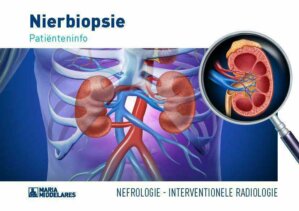Kidney biopsy
What is it?
What is it?A kidney biopsy is an examination in which a special needle (biopsy needle) is used to remove small pieces of tissue from one kidney.
This is done by inserting a needle into the kidney through the skin, under a local anaesthetic.
The needle is inserted into the kidney under ultrasound guidance and, in exceptional cases, under CT guidance. These techniques allow imaging of the kidney and the needle.
The examination itself takes place in the operating theatre and is performed by an interventional radiologist. This is a radiologist who specialises in performing minimally invasive procedures under imaging.
The pieces of tissue are examined under the microscope in the laboratory. This enables us to determine the nature and severity of your kidney problem and to start the appropriate treatment.
Preparation for the procedure
Preparation for the procedureDuring the consultation, the nephrologist (= kidney specialist) will ask about your medication use .
- You must definitely mention use of blood thinners (e.g. Marevan®, Sintrom®, Plavix®, Asaflow®, Cardioaspirine®, Xarelto®, Eliquis®, Pradaxa®). In consultation with the nephrologist, the blood thinners will be stopped a few days before the kidney biopsy. This is done to prevent possible bleeding after the biopsy.
- Any other medication is also discussed. You will be able to continue taking some medication.
Are you allergic to certain substances (medications, latex, contrast medium)? Do not forget to mention this to your nephrologist during the consultation and on your admission.
If you are pregnant, make sure to let the nephrologist know. Biopsies during pregnancy are only performed in exceptional cases.
Also have a blood sample taken by your GP or nephrologist that checks coagulation. Your nephrologist or interventional radiologist can only perform the biopsy once the results of the blood tests have been received.
Course of the procedure
Course of the procedure- On the day of the procedure, you may take a light breakfast since the biopsy is usually performed in the afternoon. View the guidelines for eating and drinking here.
- In the hospital, a nurse will take down your details. Your blood pressure, pulse and temperature will be measured and a final blood sample may be taken.
- The nurse will give you a surgical shirt to put on in the room.
- Fifteen minutes before the procedure you will be transported, in your bed, to the radiological intervention room in the Surgery Department. You are asked to lie down on your right or left side. The examination starts with an ultrasound examination of the kidney. This makes it possible to determine a good puncture site on the skin. If necessary, some pillows are put under the lumbar region to make it easier to insert the needle in the kidney. The skin is disinfected and a sterile sheet is placed. Then, a local anaesthetic is applied to the skin and underlying area up to the kidney, under ultrasound guidance. This is associated with a burning sensation that disappears after a few seconds.
- Almost immediately after this, the needle is inserted. A few (usually three) pieces of tissue (= biopsies) are taken from the underside of the kidney. This is usually painless; you only hear a ‘click’ when the tissue sample is taken.
- After the biopsy, firm pressure is applied to the puncture site.
- Before you leave the operating theatre, a final ultrasound check is performed.
After the procedure
After the procedure- After the procedure, and if there are no problems, you may eat and drink something after approximately an hour.
- You will remain in bed for a maximum of 24 hours, lying on your back. You may not get up until after the ultrasound check-up and blood collection the following morning. Up to six hours after the procedure, a sandbag is placed on the puncture site. These measures are necessary to minimise the risk of bleeding at the puncture site.
- The nurse will come to your room to carry out regular checks of your blood pressure and pulse rate. The dressing that has been applied to the puncture site will also be checked regularly.
- To prevent bleeding, you may not get up to visit the toilet. If necessary, ask for a bedpan or urinal. The first urine may be coloured pink or red. That is normal and is caused by the needle being inserted into the kidney.
- In case of pain or discomfort, always inform the nurse.
- You will stay one night in hospital for further observation and checks. The morning after the biopsy, an ultrasound will be performed at the Radiology Department to check your kidneys. Blood samples will be taken at the ward. Then, the attending nephrologist decides if you may leave the hospital.
- Before your hospital discharge, a date for your next consultation with the nephrologist is agreed. During this consultation, the results of the biopsy and any further treatment is discussed.
Guidelines for at home
Guidelines for at homeStrenuous effort must be avoided in the first week after the biopsy.
If, after your discharge from hospital, you have any of the following symptoms: Contact the nephrology service or, outside office hours, the hospital's A&E department.
| Fever | Pinkish-red urine |
| Pain around the biopsy site | Generally unwell |
Leaflet
LeafletMore information about kidney biopsies and possible complications can be found in the leaflet below.
Only available in Dutch:

Nierbiopsie
DownloadCentres and specialist areas
Centres and specialist areas
Something wrong or unclear on this page? Report it.
Latest publication date: 13/08/2024
Supervising author: Dr Schoofs Christophe, Dr De Vleeschouwer Mieke






